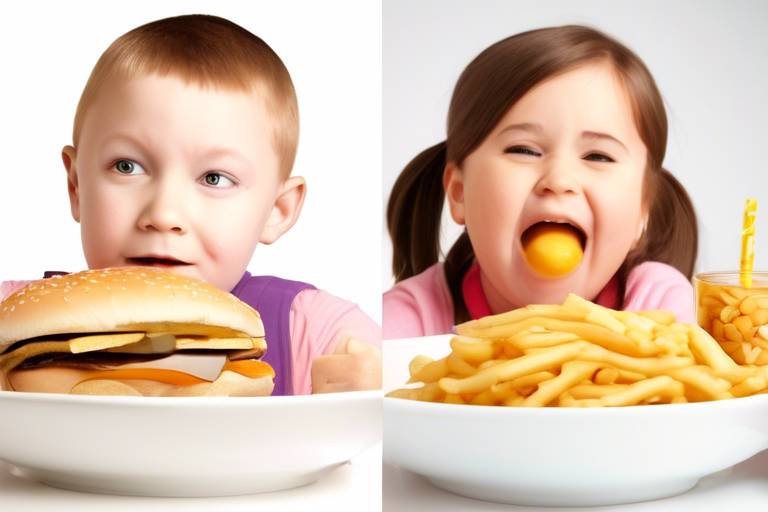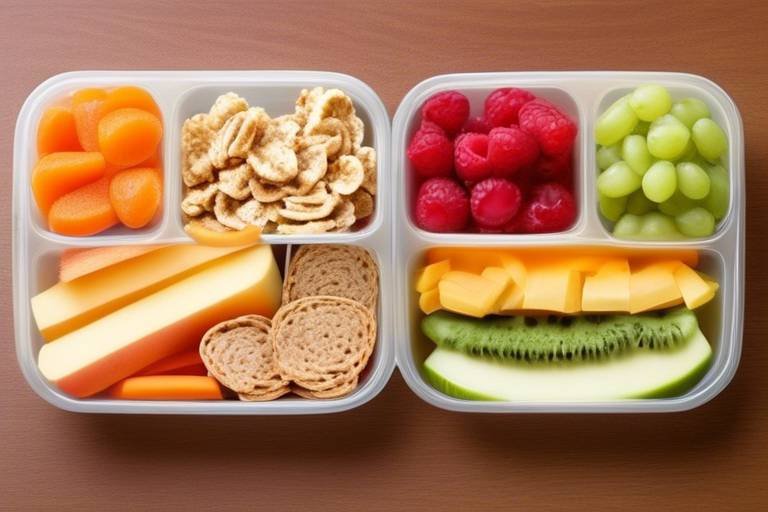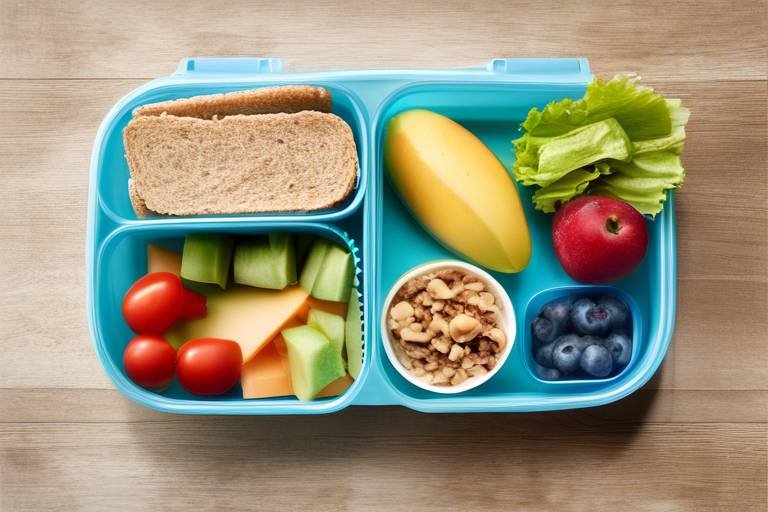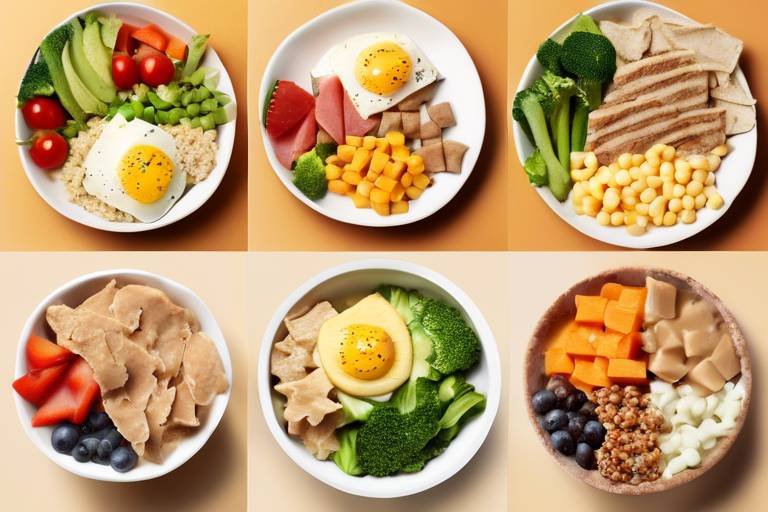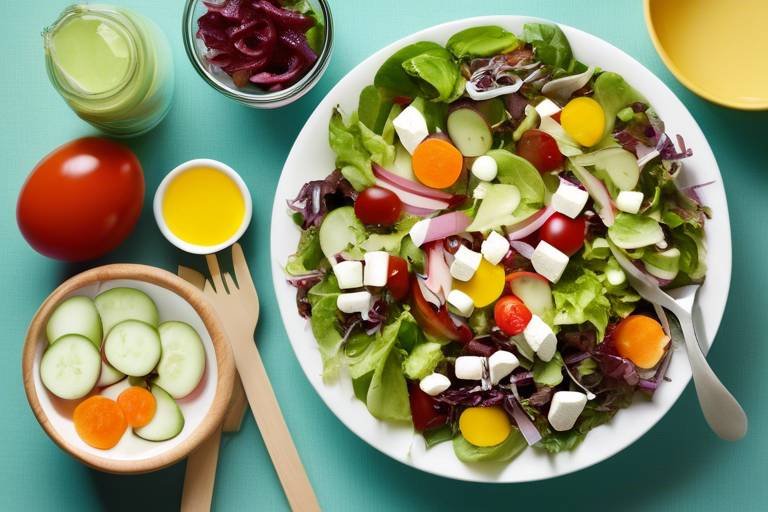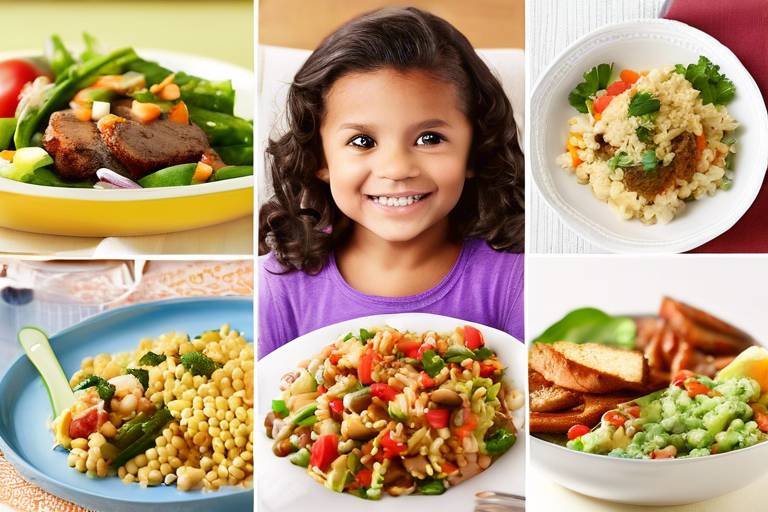Good Fat vs Bad Fat: Understanding the Basics for Kids
Welcome to the world of fats! You might think that all fats are bad, but that’s not the case at all. In fact, fats are like the superheroes of our diet, playing a crucial role in keeping our bodies healthy and energetic. Think of fats as the fuel that powers your favorite video game or the energy that helps you run around the playground. This article aims to educate you about the differences between good fats and bad fats, their importance in our diet, and how you can make healthier food choices every day!
Fats are essential nutrients that our bodies need for energy and growth. Just like how a car needs gasoline to run, our bodies need fats to function properly. They help us absorb vitamins, support cell growth, and even keep our skin healthy! But not all fats are created equal. Some are beneficial, while others can be harmful if we eat too much of them. So, let's dive deeper into the fascinating world of fats!
Good fats, often referred to as unsaturated fats, are beneficial for our heart health and can help lower bad cholesterol levels. Imagine these good fats as the friendly neighborhood helpers, working tirelessly to keep your heart strong and your body feeling great! Learning about these fats can encourage healthier eating habits in kids, leading to a lifetime of good choices.
So, where can you find these amazing good fats? They can be found in a variety of delicious foods! Here are some common sources:
- Avocados: Creamy and full of flavor!
- Nuts: Crunchy snacks that pack a punch!
- Seeds: Tiny but mighty sources of nutrition!
- Olive oil: A smooth and tasty addition to meals!
Avocados are packed with monounsaturated fats, which are heart-healthy and delicious! They also provide essential vitamins and minerals, making them a nutritious addition to any meal or snack. You can slice them up for a sandwich, mash them for a dip, or even blend them into smoothies. The possibilities are endless!
Nuts and seeds are excellent sources of good fats, protein, and fiber. They make for a great snack and can easily be included in various recipes for added nutrition. Whether you’re munching on almonds during a movie or sprinkling chia seeds on your yogurt, these tiny foods can have a big impact on your health.
Incorporating good fats into your diet can improve brain function, support cell growth, and help absorb essential vitamins. They are like the building blocks of a strong and healthy body! Understanding these benefits can motivate kids to choose healthier options. Remember, eating the right types of fats can make you feel more energetic and focused, just like charging up your favorite video game character!
Now, let’s talk about the other side of the coin—bad fats. These are primarily saturated fats and trans fats. They can lead to health issues like obesity and heart disease if consumed in excess. It’s essential for kids to learn about these fats and how to limit their intake. Think of bad fats as the villains in our story; they might seem appealing at first, but they can cause trouble if we let them take over our diets!
Bad fats are commonly found in processed foods, fried items, and baked goods. Here are some examples:
- Fast food: Burgers and fries that are tasty but not so healthy.
- Baked goods: Cookies and pastries that are high in trans fats.
- Snack foods: Chips and crackers that may contain unhealthy oils.
Consuming too many bad fats can increase the risk of serious health problems, including heart disease and diabetes. Understanding these risks is important for kids to develop lifelong healthy eating habits. By choosing to limit bad fats, you are taking a step towards a healthier future. Remember, just like superheroes have weaknesses, our diets can have their own if we aren't careful!
1. What are some examples of good fats?
Good fats include avocados, nuts, seeds, and olive oil. They help keep your heart healthy!
2. Why are bad fats harmful?
Bad fats, like trans fats and saturated fats, can lead to health issues such as obesity and heart disease when consumed in excess.
3. How can I make healthier food choices?
You can make healthier choices by opting for foods rich in good fats, like avocados and nuts, while limiting processed and fried foods.

What Are Fats?
This article aims to educate children about the differences between good and bad fats, their importance in our diet, and how to make healthier food choices.
Fats are essential nutrients that our bodies need for energy and growth. They are not just something we should avoid; in fact, they play a vital role in maintaining our overall health! Think of fats as the fuel that keeps our engine running. Without them, our bodies would struggle to perform everyday activities. But just like how not all fuel is created equal, not all fats are beneficial to our health. It's crucial to understand the different types of fats we consume.
Fats can be categorized into two main types: good fats and bad fats. Good fats, which are often unsaturated, are beneficial for our heart and can help lower bad cholesterol levels. On the flip side, bad fats, primarily saturated and trans fats, can lead to health issues like obesity and heart disease. So, knowing the difference can help us make smarter food choices!
Here’s a quick breakdown to make it easier:
| Type of Fat | Examples | Health Impact |
|---|---|---|
| Good Fats | Avocados, Nuts, Olive Oil | Heart-healthy, lowers bad cholesterol |
| Bad Fats | Fried Foods, Processed Snacks | Increases risk of obesity and heart disease |
Understanding these differences is not just about avoiding certain foods; it's about making informed choices that can lead to a healthier lifestyle. So, the next time you grab a snack or choose a meal, remember to think about the type of fat you're consuming. Are you fueling your body with good fats or bad fats? This awareness can empower you to make choices that benefit your health in the long run!
Good fats, often referred to as unsaturated fats, are beneficial for heart health and can help lower bad cholesterol levels. Learning about these fats can encourage healthier eating habits in kids.
Good fats can be found in foods like avocados, nuts, seeds, and olive oil. Understanding where to find these healthy options is crucial for making better dietary choices.
Avocados are packed with monounsaturated fats, which are heart-healthy. They also provide vitamins and minerals, making them a nutritious addition to any meal or snack.
Nuts and seeds are excellent sources of good fats, protein, and fiber. They make for a great snack and can easily be included in various recipes for added nutrition.
Incorporating good fats into your diet can improve brain function, support cell growth, and help absorb essential vitamins. Understanding these benefits can motivate kids to choose healthier options.
Bad fats, primarily saturated and trans fats, can lead to health issues like obesity and heart disease. It's essential for kids to learn about these fats and how to limit their intake.
Bad fats are commonly found in processed foods, fried items, and baked goods. Identifying these foods can help kids make healthier choices in their diets.
Consuming too many bad fats can increase the risk of serious health problems. Understanding these risks is important for kids to develop lifelong healthy eating habits.
- What are the main types of fats? There are two main types of fats: good fats (unsaturated) and bad fats (saturated and trans).
- Why are good fats important? Good fats help lower bad cholesterol, support heart health, and provide energy.
- How can I identify bad fats in foods? Bad fats are often found in processed, fried, and baked foods. Always check the nutrition label!
- Can I completely avoid bad fats? While it's important to limit bad fats, it's okay to enjoy them occasionally as part of a balanced diet.

Good Fats Explained
When we talk about good fats, we're diving into a world of nutrients that are not just tasty but also incredibly beneficial for our bodies. These fats, known as unsaturated fats, are like the superheroes of the dietary world. They swoop in to save the day by promoting heart health and helping to lower those pesky bad cholesterol levels. Imagine your body as a car; good fats are the high-quality fuel that keeps everything running smoothly. Without them, you might find yourself sputtering along, struggling to keep up with the demands of daily life.
So, what makes good fats so special? For starters, they are essential for energy production and are crucial for the growth and development of our bodies. Think of them as the building blocks that help us grow strong and healthy. They also play a significant role in keeping our skin healthy and our brains functioning at their best. Yes, you heard that right! Good fats can even help improve your brain function, making it easier to focus and learn new things. Who wouldn't want that?
Now, let's talk about where we can find these amazing good fats. Foods rich in unsaturated fats include:
- Avocados - Creamy, delicious, and packed with nutrients.
- Nuts - A crunchy snack that’s full of healthy fats and protein.
- Seeds - Tiny powerhouses of nutrition that can easily be added to many dishes.
- Olive oil - A staple in many kitchens, perfect for cooking or drizzling on salads.
Each of these foods not only provides good fats but also comes with a host of other nutrients that support overall health. For instance, avocados are not just about the good fats; they also contain vitamins like E, K, and C, which are essential for a healthy body. Similarly, nuts and seeds offer not just healthy fats but also protein and fiber, making them a fantastic snack option.
To illustrate just how beneficial these good fats can be, let’s take a look at some of their key benefits:
| Benefit | Description |
|---|---|
| Heart Health | Good fats help lower bad cholesterol levels, reducing the risk of heart disease. |
| Brain Function | They support cognitive functions, helping with memory and learning. |
| Vitamin Absorption | Good fats aid in absorbing fat-soluble vitamins like A, D, E, and K. |
| Cell Growth | They are essential for the growth and repair of cells in our body. |
In conclusion, understanding good fats is not just about knowing what to eat; it's about making informed choices that can lead to a healthier lifestyle. By incorporating good fats into your diet, you’re not just treating your taste buds; you’re also giving your body the fuel it needs to thrive. So, next time you're snacking or planning a meal, think about those good fats and how they can help you become the best version of yourself!

Sources of Good Fats
When it comes to good fats, knowing where to find them can make a world of difference in your diet. These healthy fats are not only delicious but also play a vital role in keeping your body functioning at its best. So, what are some of the top sources of good fats that kids can enjoy? Let’s dive into a few tasty options!
One of the most popular sources of good fats is the avocado. This creamy fruit is loaded with monounsaturated fats, which are known for their heart-healthy benefits. Avocados are not just tasty; they’re also packed with vitamins and minerals that help your body grow and stay healthy. You can slice them up in salads, mash them on toast, or even blend them into smoothies for a nutritious boost!
Another fantastic source of good fats comes from nuts and seeds. These little powerhouses are rich in healthy fats, protein, and fiber. Whether you prefer almonds, walnuts, chia seeds, or flaxseeds, there’s a nut or seed for everyone! They make for a perfect snack on their own, but you can also sprinkle them on yogurt or mix them into oatmeal for added crunch and nutrition.
Don’t forget about olive oil, a staple in many kitchens around the world. This oil is not only great for cooking but also a wonderful dressing for salads. It’s another source of monounsaturated fats that can help reduce bad cholesterol levels. When you choose olive oil over butter or margarine, you’re making a healthier choice that your heart will thank you for!
In addition to these, there are other sources of good fats that can easily be included in your meals. For example:
- Fatty fish like salmon and mackerel are rich in omega-3 fatty acids, which are essential for brain health.
- Dark chocolate (in moderation) contains healthy fats and antioxidants, making it a sweet treat that can also be good for you!
- Coconut oil is another option, especially for cooking, as it provides a unique flavor along with healthy fats.
By incorporating these sources of good fats into your diet, you can enjoy tasty meals while also fueling your body with the nutrients it needs. So the next time you’re planning your meals or snacks, think about adding some of these healthy options to your plate!
- What are the main types of good fats? Good fats primarily include monounsaturated and polyunsaturated fats.
- How can I tell if a fat is good or bad? Generally, if the fat comes from whole foods like avocados, nuts, and fish, it’s likely a good fat. Processed fats often fall into the bad category.
- Can I eat good fats every day? Yes! Incorporating good fats into your daily diet can be beneficial, but moderation is key.

Avocados: A Superfood
When you think about superfoods, avocados should definitely come to mind! These creamy green fruits are not just delicious; they are also packed with an array of nutrients that can benefit your body in numerous ways. One of the standout features of avocados is their high content of monounsaturated fats, which are known to be heart-healthy. Unlike bad fats, these good fats can actually help lower your bad cholesterol levels, making avocados a fantastic choice for maintaining a healthy heart.
But that's not all! Avocados are also loaded with vitamins and minerals that are crucial for your growth and development. For instance, they are rich in potassium, which helps regulate blood pressure, and vitamin E, a powerful antioxidant that protects your cells from damage. Adding avocados to your diet can be as simple as spreading them on toast, tossing them into salads, or even blending them into smoothies for a creamy texture.
Here’s a quick look at some of the amazing benefits of avocados:
- Heart Health: The monounsaturated fats in avocados can help reduce the risk of heart disease.
- Weight Management: Despite being high in calories, avocados can help keep you full longer, reducing the chances of overeating.
- Improved Digestion: They are a good source of fiber, which aids in digestion and helps maintain a healthy gut.
- Skin and Hair Benefits: The healthy fats and vitamins in avocados can promote healthy skin and shiny hair.
Incorporating avocados into your meals is not only easy but also fun! You can use them in various ways, such as:
| Dish | How to Use Avocados |
|---|---|
| Guacamole | Mash avocados with lime, salt, and your favorite spices for a tasty dip! |
| Salads | Dice avocados and toss them in salads for added creaminess and nutrition. |
| Smoothies | Blend avocados into smoothies for a rich, creamy texture without dairy. |
| Toast | Spread mashed avocado on toast and top with your favorite ingredients. |
So, the next time you're looking for a healthy snack or a way to jazz up your meals, remember the incredible avocado! Not only are they versatile, but they also pack a powerful punch when it comes to nutrition. By making avocados a regular part of your diet, you're taking a big step toward a healthier lifestyle.
1. Are avocados high in calories?
Yes, avocados are relatively high in calories due to their fat content, but they are filled with healthy fats that are beneficial for your body.
2. Can I eat avocados every day?
Absolutely! Eating avocados daily can provide numerous health benefits, but moderation is key, as they are calorie-dense.
3. How can I tell if an avocado is ripe?
A ripe avocado will yield slightly to gentle pressure when squeezed. If it feels hard, it's not ready yet!
4. What are some recipes that include avocados?
Avocados can be used in various recipes, including guacamole, salads, smoothies, and even desserts!

Nuts and Seeds
Nuts and seeds are not just tasty snacks; they are also powerhouses of nutrition that can play a significant role in a healthy diet. These little gems are packed with good fats, protein, vitamins, and minerals that are essential for our bodies. When you munch on a handful of nuts or sprinkle seeds on your meals, you are not only satisfying your taste buds but also fueling your body with the nutrients it craves.
One of the best things about nuts and seeds is their versatility. You can enjoy them in various ways, whether it's as a snack on their own, mixed into yogurt, or added to salads and smoothies. For example, almonds are great for snacking, while chia seeds can be blended into a smoothie for an extra boost of energy. Here’s a quick look at some popular nuts and seeds and their benefits:
| Type | Benefits | Serving Suggestions |
|---|---|---|
| Almonds | Rich in vitamin E, magnesium, and fiber | Snack on them raw or add to salads |
| Walnuts | High in omega-3 fatty acids, good for brain health | Chop and sprinkle on oatmeal or yogurt |
| Chia Seeds | Loaded with fiber, antioxidants, and calcium | Add to smoothies or make chia pudding |
| Sunflower Seeds | Great source of vitamin E and healthy fats | Mix into trail mix or sprinkle on salads |
In addition to being nutritious, nuts and seeds are also very filling, which can help curb hunger and reduce the temptation to reach for unhealthy snacks. They are the perfect choice for kids who need energy for playtime or studying. Just remember, moderation is key! A small handful is usually enough to reap the benefits without overdoing it.
So, next time you're looking for a snack, consider grabbing some nuts or seeds. They are not only delicious but also a fantastic way to incorporate good fats into your diet. Your body will thank you!
Q: Are all nuts and seeds healthy?
A: While most nuts and seeds are healthy, it's important to choose unsalted and unprocessed varieties to avoid extra sodium and unhealthy fats.
Q: How many nuts should I eat in a day?
A: A small handful (about 1 ounce) is a good serving size to enjoy the health benefits without consuming too many calories.
Q: Can I eat nuts if I have a nut allergy?
A: If you have a nut allergy, it's best to avoid all nuts and consult with a healthcare provider for safe alternatives.
Q: What are some good recipes that include nuts and seeds?
A: You can try making energy bars, smoothies, or adding them to salads and baked goods for extra crunch and nutrition.

Benefits of Good Fats
This article aims to educate children about the differences between good and bad fats, their importance in our diet, and how to make healthier food choices.
Fats are essential nutrients that our bodies need for energy and growth. They play a vital role in maintaining overall health, but it's important to understand the different types of fats we consume.
Good fats, often referred to as unsaturated fats, are beneficial for heart health and can help lower bad cholesterol levels. Learning about these fats can encourage healthier eating habits in kids.
Good fats can be found in foods like avocados, nuts, seeds, and olive oil. Understanding where to find these healthy options is crucial for making better dietary choices.
Avocados are packed with monounsaturated fats, which are heart-healthy. They also provide vitamins and minerals, making them a nutritious addition to any meal or snack.
Nuts and seeds are excellent sources of good fats, protein, and fiber. They make for a great snack and can easily be included in various recipes for added nutrition.
Incorporating good fats into your diet can improve brain function, support cell growth, and help absorb essential vitamins. These fats are like the superheroes of the food world, swooping in to save the day by keeping our bodies functioning at their best!
First off, good fats are crucial for brain development. Did you know that our brains are made up of nearly 60% fat? That's right! Consuming healthy fats helps in the formation of brain cells and enhances cognitive functions. Imagine your brain as a high-performance car; good fats are the premium fuel that keeps it running smoothly.
Moreover, good fats play a significant role in cell growth and repair. Every cell in our body has a membrane made of fat, and without the right kinds of fats, these cells can’t function properly. Just like a garden needs water and sunlight to thrive, our cells need good fats to grow strong and healthy.
Another fantastic benefit is that good fats help our bodies absorb essential vitamins, such as A, D, E, and K. These vitamins are fat-soluble, meaning they need fat to be effectively absorbed. Think of good fats as the friendly guides that help vitamins enter the body’s treasure chest of nutrients!
Additionally, including good fats in your diet can also help keep you feeling full and satisfied. When you eat foods rich in unsaturated fats, they can curb your cravings and prevent you from reaching for unhealthy snacks. It’s like having a loyal friend who always has your back when you’re tempted by junk food!
In summary, good fats are not just a tasty addition to your meals; they are essential for a healthy lifestyle. By choosing foods rich in unsaturated fats, you’re not just fueling your body; you’re also making a smart choice for your brain and overall health!
Bad fats, primarily saturated and trans fats, can lead to health issues like obesity and heart disease. It's essential for kids to learn about these fats and how to limit their intake.
Bad fats are commonly found in processed foods, fried items, and baked goods. Identifying these foods can help kids make healthier choices in their diets.
Consuming too many bad fats can increase the risk of serious health problems. Understanding these risks is important for kids to develop lifelong healthy eating habits.
- What are good fats? Good fats are unsaturated fats that are beneficial for heart health and overall well-being.
- Why are good fats important? They help in brain development, cell growth, and the absorption of essential vitamins.
- Can I eat fats every day? Yes, incorporating good fats into your daily diet is healthy, but it's important to limit bad fats.
- What foods contain good fats? Foods like avocados, nuts, seeds, and olive oil are great sources of good fats.
- How can I avoid bad fats? Limit processed foods, fried items, and baked goods, and opt for whole, natural foods instead.

Bad Fats Explained
When we talk about bad fats, we're primarily referring to two types: saturated fats and trans fats. These fats can be sneaky little devils in our diets, often hiding in delicious-looking snacks and meals. But don’t be fooled! While they might taste good, they can lead to some serious health issues if consumed in excess. It's crucial for kids, and even adults, to understand what these fats are and how they can impact our bodies.
Saturated fats are typically found in animal products like butter, cheese, and red meat, as well as some plant oils like coconut and palm oil. When you eat too many saturated fats, they can raise the levels of bad cholesterol in your blood, which can increase the risk of heart disease. Imagine cholesterol as tiny delivery trucks on the road of your arteries; if there are too many bad trucks, they can cause traffic jams, leading to serious problems!
On the other hand, trans fats are even trickier. They are often created through an industrial process that adds hydrogen to liquid vegetable oils to make them more solid. This process helps prolong shelf life, which is why you might find trans fats in many processed foods like cookies, crackers, and fried foods. Not only do trans fats raise bad cholesterol, but they also lower your good cholesterol, making them a double whammy for your heart health. It's like having a friend who not only takes your snacks but also makes sure you can’t get any more!
To help kids spot these bad fats, here are some common sources to watch out for:
- Fast food items like burgers and fries
- Packaged snacks such as chips and cookies
- Baked goods made with shortening or margarine
- Processed meats like sausages and hot dogs
Understanding the health risks associated with bad fats is essential for developing healthy eating habits. Regularly consuming these fats can lead to serious health issues, including:
| Health Risk | Description |
|---|---|
| Obesity | Excess calories from bad fats can lead to weight gain. |
| Heart Disease | High cholesterol levels can clog arteries, leading to heart issues. |
| Type 2 Diabetes | Bad fats can contribute to insulin resistance. |
So, the next time you're at the store or munching on a snack, remember that not all fats are created equal. By learning to identify bad fats and limit their intake, kids can set themselves up for a healthier future. It's all about making those smart choices and fueling our bodies with the good stuff!
1. What are some examples of good fats?
Good fats include avocados, olive oil, nuts, and fatty fish like salmon. These fats can help improve heart health and provide essential nutrients.
2. How can I tell if a food has trans fats?
You can check the nutrition label on food packaging. If it lists "partially hydrogenated oils," it's a sign that the food contains trans fats.
3. Is it okay to eat bad fats sometimes?
Yes, it's all about moderation! It's okay to enjoy treats occasionally, but try to limit your intake of bad fats in your everyday diet.

Sources of Bad Fats
When it comes to understanding bad fats, it’s essential to know where they hide in our food. Bad fats primarily come from two types: saturated fats and trans fats. These fats can sneak into our meals in ways we might not even realize. For instance, many of our favorite fast foods, snacks, and even some desserts contain these unhealthy fats. But don’t worry, we’re going to uncover the culprits!
Saturated fats are often found in animal products. Think about the deliciousness of a juicy burger or a cheesy pizza. While they may taste amazing, they are usually loaded with saturated fats. You can find these fats in:
- Fatty cuts of meat (like bacon and sausage)
- Full-fat dairy products (like cream, cheese, and butter)
- Coconut oil and palm oil (often used in processed foods)
On the other hand, trans fats are the real villains in our diet. These are artificially created fats made through a process called hydrogenation, which makes liquid oils solid. They are often used in processed foods to improve texture and shelf life. You might find trans fats in:
- Fried foods (like French fries and doughnuts)
- Baked goods (like cookies, cakes, and pastries)
- Snack foods (like microwave popcorn and chips)
It's crucial for kids to learn how to spot these bad fats on food labels. Many packaged foods list the types of fats they contain, so always check for “partially hydrogenated oils” which indicate the presence of trans fats. Moreover, if you see the word "saturated" followed by a number, that’s a clue that the food might not be the best choice.
By identifying these sources of bad fats, kids can make smarter food choices. Remember, it’s not just about avoiding these fats altogether; it’s about balancing them with good fats in a healthy diet. Next time you're at the grocery store or picking out snacks, think about whether you’re choosing foods that are nourishing your body or just filling it up with empty calories!
Q: What are good fats and why are they important?
A: Good fats, such as unsaturated fats, are essential for heart health, brain function, and overall well-being. They help lower bad cholesterol levels and provide energy.
Q: How can I tell if a food has bad fats?
A: Check the nutrition label for saturated and trans fats. If it lists “partially hydrogenated oils,” it contains trans fats, which are unhealthy.
Q: Are all fats bad?
A: No, not all fats are bad! Good fats are necessary for your body, while bad fats should be limited.
Q: Can I still enjoy my favorite foods?
A: Yes! It’s all about balance. You can enjoy your favorite foods occasionally, but try to pair them with healthy options.

Health Risks of Bad Fats
This article aims to educate children about the differences between good and bad fats, their importance in our diet, and how to make healthier food choices.
Fats are essential nutrients that our bodies need for energy and growth. They play a vital role in maintaining overall health, but it's important to understand the different types of fats we consume.
Good fats, often referred to as unsaturated fats, are beneficial for heart health and can help lower bad cholesterol levels. Learning about these fats can encourage healthier eating habits in kids.
Good fats can be found in foods like avocados, nuts, seeds, and olive oil. Understanding where to find these healthy options is crucial for making better dietary choices.
Avocados are packed with monounsaturated fats, which are heart-healthy. They also provide vitamins and minerals, making them a nutritious addition to any meal or snack.
Nuts and seeds are excellent sources of good fats, protein, and fiber. They make for a great snack and can easily be included in various recipes for added nutrition.
Incorporating good fats into your diet can improve brain function, support cell growth, and help absorb essential vitamins. Understanding these benefits can motivate kids to choose healthier options.
Bad fats, primarily saturated and trans fats, can lead to health issues like obesity and heart disease. It's essential for kids to learn about these fats and how to limit their intake.
Bad fats are commonly found in processed foods, fried items, and baked goods. Identifying these foods can help kids make healthier choices in their diets.
Consuming too many bad fats can lead to serious health problems. These fats can clog arteries, increase cholesterol levels, and contribute to weight gain. When kids eat foods high in bad fats, they might not realize the potential consequences. Here are some of the health risks associated with bad fats:
- Obesity: Eating a lot of bad fats can lead to weight gain, which can make kids feel sluggish and less active.
- Heart Disease: Bad fats can raise cholesterol levels, increasing the risk of heart disease even at a young age.
- Diabetes: A diet high in bad fats can lead to insulin resistance, which is a precursor to type 2 diabetes.
- Fatty Liver Disease: Too many unhealthy fats can cause fat to build up in the liver, leading to liver problems.
Understanding these risks is important for kids to develop lifelong healthy eating habits. By making informed choices and opting for healthier fats, they can enjoy a vibrant and energetic life. Remember, it's not just about avoiding bad fats; it's about embracing good fats that keep our bodies feeling great!
1. What are good fats?
Good fats, also known as unsaturated fats, are beneficial for your heart and overall health. They can be found in foods like avocados, nuts, and olive oil.
2. Why are bad fats harmful?
Bad fats, such as saturated and trans fats, can lead to serious health issues like obesity, heart disease, and diabetes when consumed in excess.
3. How can I identify bad fats in food?
Look for terms like "partially hydrogenated oils" and "high in saturated fat" on food labels. These indicate the presence of bad fats.
4. Can I eat fats and still be healthy?
Absolutely! Just focus on incorporating good fats into your diet while limiting the intake of bad fats for a balanced approach to nutrition.
Frequently Asked Questions
- What are the differences between good fats and bad fats?
Good fats, known as unsaturated fats, are beneficial for our health, helping to lower bad cholesterol and support heart health. Bad fats, such as saturated and trans fats, can lead to health issues like heart disease and obesity. Understanding these differences is crucial for making healthier food choices.
- Can you give examples of foods that contain good fats?
Absolutely! Foods rich in good fats include avocados, nuts, seeds, and olive oil. These foods not only taste great but also provide essential nutrients that our bodies need to function properly.
- Why are good fats important for kids?
Good fats are essential for children's growth and development. They help with brain function, support cell growth, and assist in absorbing important vitamins. Including good fats in a child's diet can lead to healthier eating habits and overall better health.
- What foods should I avoid to limit bad fats?
To limit bad fats, it's best to avoid processed foods, fried items, and baked goods. These foods often contain high levels of saturated and trans fats, which can be harmful to health if consumed in excess.
- How can I encourage my kids to eat more good fats?
Making good fats fun and accessible can help! Try incorporating avocados into smoothies, adding nuts to yogurt, or using olive oil in salad dressings. Kids are more likely to enjoy these healthy options when they are presented in tasty and appealing ways.
- What are the health risks associated with consuming too many bad fats?
Consuming excessive bad fats can increase the risk of serious health problems, including obesity, heart disease, and high cholesterol levels. It's important for kids to understand these risks to develop lifelong healthy eating habits.
- How can I teach my kids about fats in a fun way?
Engaging kids in cooking activities can be a fun way to teach them about fats. You can have them help prepare meals using good fats or create a "fat chart" showing different foods and their fat content. Making it interactive will keep them interested and informed!

